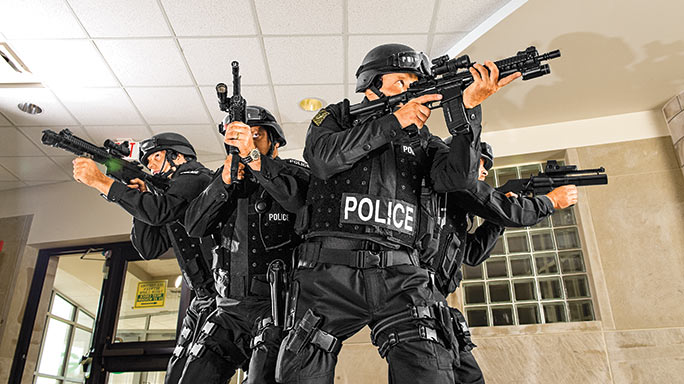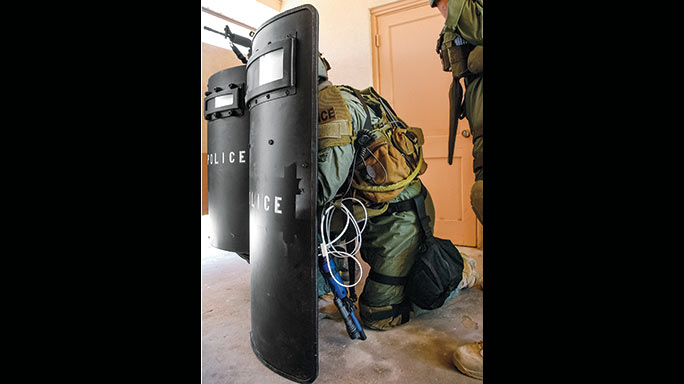It’s a tough time to be a cop. At the local, state and federal levels, this type of violence against law enforcement hasn’t been seen since the 1970s.
Ambushes against officers have escalated, such as the recent incident in which Deputy Darren Goforth of the Harris County, Texas, Sheriff’s Office was shot to death as he refueled his patrol car. Deputy Goforth was shot for no other reason than the uniform he was wearing.
- RELATED STORY: 9 Cases That Show How LEOs Can Stop Ambush Killers
So how do you prepare newly hired police officers for this level of violence? In the relatively short period of time of a basic police academy, how do you develop their skills, attributes and abilities to the point where they can dominate and win a violent encounter? Especially considering that officer safety, firearms and subject control are only small parts of the overall academy training curriculum. How can it be done? Keeping in mind that budgets for most agencies across the country have been slashed, and money for everything from bullets to training staff reduced, can it be done? The answer is yes, and here’s how.
Advertisement — Continue Reading Below
Better Training
If I were to tell you that training is the answer for a law enforcement officer to win an armed encounter, you might think I’m stating the obvious. But far too many basic academy or in-service training programs are not training—they’re activities based around passing qualifications.
In every basic academy, it is true that a cadet will not be certified or graduate if they do not pass their basic firearms training standards. Sadly, this then becomes the goal—to pass or qualify. Not to be proficient or skilled enough to survive a gunfight. And understand that qualifications are only minimal displays of skills.
Advertisement — Continue Reading Below
These standards usually evolve to cadets standing in one spot and delivering accurate fire. Seemingly a laudable goal, the qualification course becomes the standard that basic and in-service officers must meet. “Training” then revolves around learning those skills and events required to pass the qualification course. Time is minimal, and a true grasp of the fundamentals is not possible in the time allowed. It’s “learn enough to pass” and then move on.
Think of the proper use-of-force training progression as a circle, and the first step is understanding legal standards surrounding this issue. The Supreme Court of the United States laid the foundation for the use of force with Tennessee v. Garner and Graham v. Connor. While Garner covers the use of deadly force to apprehend fleeing felons, in Graham v. Connor SCOTUS applies the “objective reasonableness” test to non-deadly force and offers more guidance as to how force is to be judged and factors that may be considered.
- RELATED STORY: Helpful Driving Tactics For Law Enforcement
For over four years, I taught new firearms instructors their business for my state academy. Giving hypothetical scenarios for the use of deadly force, I was flummoxed by the number of cops who didn’t know the laws concerning use of force. Having taught officer-involved shooting investigations, I can also state that far too many chiefs and other police agency brass don’t know the law, either.
Advertisement — Continue Reading Below
This deficit seriously impacts officer decision-making. Quite frankly, if you don’t know when you can shoot, your physical ability to get rounds on target is moot. Far too many police officers are killed each year because they never drew their firearms.
If we examine the last 10 years of officers killed summaries by the FBI, and we exclude officers killed in ambushes (those who never had a chance or were unaware of their assailant), we see that 60 percent of the officers killed did not use or attempt to use their own firearm. I believe that this results from a lack of decision-making confidence based on poor or non-existent training.
Firearms Skills
Advertisement — Continue Reading Below
The next stop on our training circle: We must introduce firearms skills that work under stress. Overly complicated movements based on fine motor skills will fall apart under stress. We can see how hands tremble and shake and how even the most simple movements can be fumbled just under the time constraints of qualification shoots.
Learning to properly “run the gun” is the goal here, as developed by a cadre of instructors who understand motor performance and learning. Instructors must properly instruct and demonstrate the skills being taught while understanding how adults learn as well as the differences between static, fluid and dynamic training in open and closed environments. They must also know that blocked training—standing on a static line and doing the same skill over and over—does not prepare a young officer the way that random training does.
Sufficient time and repetition must be allowed to develop the skills. Repetition is the mother of all skills, and enough must be given to develop what motor-learning scientists call “motor programs.” This does not mean that all of the training must be live fire. Indeed, dry fire is an integral part of a training program. The fundamentals of marksmanship—platform, grip, sight alignment, sight picture, trigger management, follow through and recovery—can be learned prior to ever firing a shot.
Advertisement — Continue Reading Below
New training devices can assist in this regard. A safe “non-gun” training device like the SIRT (Shot Indicating Resetting Trigger) pistol by Next Level Training replicates a Glock 17 to the point where it can be secured in my BlackHawk SERPA holster. I’ve been using the SIRT pistol over the last several months. I’ve set up cardboard and photorealistic targets in my offices and mat room with heavy emphasis on moving while drawing and after the draw. I’ve been able to incorporate empty-hand striking and kicking with my pistol training by working with a heavy bag.
In many cases, this type of training has heretofore been impossible to do safely on the live-fire range. The SIRT pistol “fires” a green laser when the trigger is pressed. On my model, a red laser is emitted when the trigger is pressed. These two laser dots allow the instructor to monitor muzzle movement during the trigger press, which is the No. 1 inhibitor to accurate fire.
Another modern training option is the use of airsoft pistols. In terms of police training, the airsoft pistol is a compressed gas launcher that fires plastic BBs. These pistols/launchers incorporate hop-up technology that imparts backspin on the BB, making it more accurate. Closely resembling the pistols commonly carried by police, airsoft pistols allow for more sophisticated training. For instance, a cadet armed with an airsoft pistol can work with another student (role-player) in simulated encounters. The role-player may draw a simulated cell phone, wallet, knife or handgun. The cadet/officer responds to the threat, moves as he or she draws and delivers accurate fire on target.
Advertisement — Continue Reading Below
Because of the low cost of airsoft pistols, BBs and green gas systems, a tremendous amount of repetition can be performed in simulations. This kind of training can be safely accomplished as long as safety gear such as eye, throat and groin protection are worn. This concept of matching the threat stimulus to the officer’s response is vital to the development of modern firearms training.
Confrontations
Repetition and practice develop competence, and that leads to confidence. Confidence helps control what can otherwise be the adverse effects of stress. A vital part of good decision making on the street is the ability to handle “fight or flight,” what scientists refer to as the Sympathetic Nervous System (SNS) response.
Advertisement — Continue Reading Below
The SNS is not an “adrenaline dump,” but rather a cascading effect that is based on the limbic system, including the hypothalamus, hippocampus and amygdala. Any threatening stimulus—think a snake on a trail—causes the secretion of a hormone in the brain and a subsequent change and possibly deleterious impact in the way we think, move, see and hear. Training doesn’t make you impervious to the effects of stress, but it can help you operate much more effectively.
Dynamic decision-making or confrontation simulation training takes the officer/student off the firing line and places them in scenarios against live role-players. Marking cartridges such as Simunition FX, ATK Force on Force or UTM cartridges can be used. Although these options are more expensive than airsoft, the realism is well worth the price. These inert marking cartridges fire out of pistols or carbines at about 400 fps and leave a star-shaped paint “mark” on the target. As long as role-players are outfitted with protective clothing, these cartridges provide invaluable training.
When the suspect has the ability to shoot back, cadets pay more attention to tactics like use of cover and don’t replicate some unrealistic tactic or technique they’ve gotten off TV or the movies. In order to properly learn in this environment, videotaping the scenarios can be extremely advantageous. And allowing the cadet to go through several scenarios will improve their performance and helps inoculate them to the adverse effects of the SNS response.
Advertisement — Continue Reading Below
Stronger Cops
Standing in one spot and punching holes in non-moving or reacting targets will help an officer or cadet get good at just that. We must get off the static shooting line and teach our people to be problem solvers and tacticians. This can be accomplished with out-of-the-box thinking and modern training tools and techniques.
- RELATED STORY: Close Quarters: 5 Expert Hand To Hand Combat Tips
It’s dangerous out there, and officers’ decisions are constantly being second-guessed by the public, the media and the legal system like never before. This demands improvements and advancements in the way we train our police officers for armed encounters. It’s time to restructure police firearms training and more properly prepare our men and women in blue. Lives hang in the balance in what has become a very complex and violent world.

























